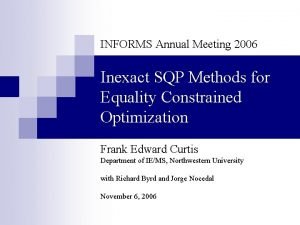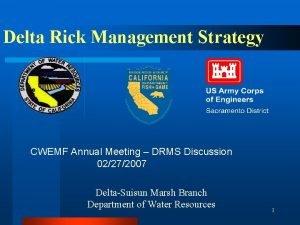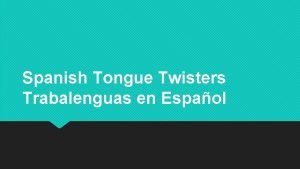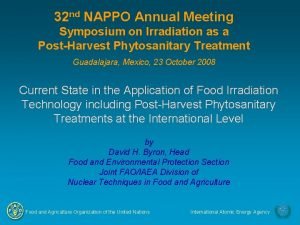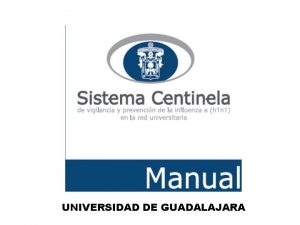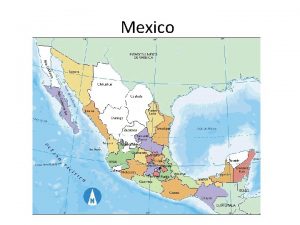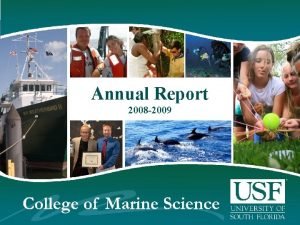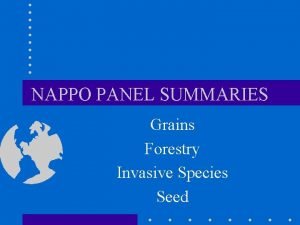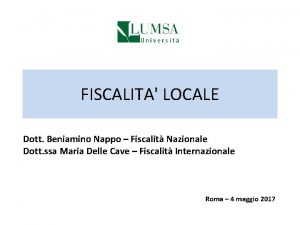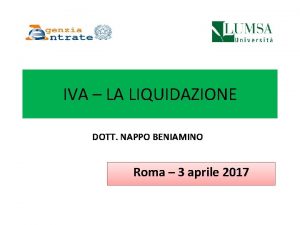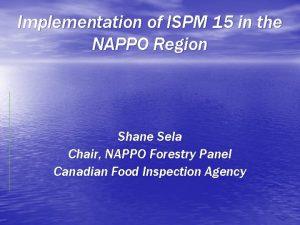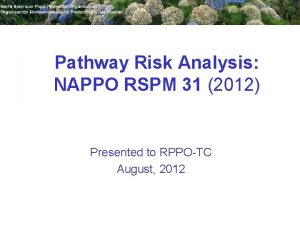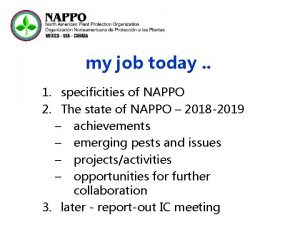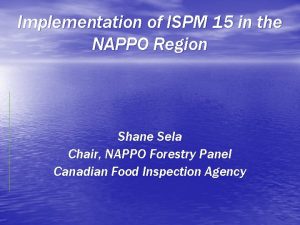2008 NAPPO Annual Meeting Guadalajara Mexico Canada Report

















- Slides: 17

2008 NAPPO Annual Meeting Guadalajara, Mexico Canada Report Greg Stubbings, Chief Plant Health Officer Director, Plant Program Integration Division October 22, 2008

Canada Report 2007 -2008 Today’s presentation includes: • Overview of CFIA organizational realignment • New strategic initiatives in Canada • Pest Situation Report 2

CFIA Organizational Realignment Gerry Ritz - Minister of Agriculture and Agri-Food Canada and Minister for the Canadian Wheat Board. Carole Swan - President of the Canadian Food Inspection Agency Sandra Wing - Vice President of new Policy and Programs Branch of the CFIA • Agency realignment included the creation of the Policy and Programs Branch in January 2008 • In June 2008, the Plant Products Directorate was re -organized under the new title of Plant Health and Biosecurity Directorate 3

Plant Health and Biosecurity Directorate Divisions Plant Program Integration Field Crops Horticulture Forestry Crop Inputs Plant Program Delivery & Destination Inspection Service 4

Plant Health Modernization Invasive Species • Increasing threat frequency, diversity, impacts • National Strategy Prevention, Early Detection, Rapid Response, Effective Management Plant Health Control and Tracking System (PHCTS) • AIRS Enhancement – Update Import Information • Import Inspection Portal & New Inspection Manual • Export Certification Lab Component (LSTS) 5

PHCTS Concept - Umbrella Web Portal Pre-shipment - Permits - Certificates Request for Release Imports CBSA - EDI Inspection Types Surveillance Export Outbreak Audit Test Certification Pre-clearance Domestic Permits Science &, Programs Policy & Procedures Activity Ledger & Reporting Inspection Triage Inspection Portal Labs (LSTS) 6

Invasive Alien Species Strengthening the established plant health program • Enhanced import inspections • Improved information management • Enhanced surveillance capacity Early detection of forest pests with CFS 3 rd party pest specific surveys Weed surveys introduced for first time (e. g. , jointed goat grass, woolly cupgrass) • • Expanded pest risk assessment capacity in entomology & botany Increased lab capabilities & capacity in nematology & entomology Expanding traditional role of Seed Lab to address IAS pressures Inspection tools – e. g. , Import Inspection Manual, Phytosanitary Treatments Manual/Database • Training tools – e. g. , PRA training for IPPC, inspector training 7

New Invasive Plants Program • Development of the Canadian Invasive Plant Framework for the engagement and cooperation of provinces, territories, nongovernment organizations, and industry groups concerned about the impacts of invasive plants; • Invasive Plant Policy development and implementation; • Examination of regulatory and non-regulatory approaches to mitigating risks associated with invasive plants; • Development of specific tools for pest risk assessment of plants as pests; • Early detection-rapid response planning; • Surveys for invasive plants; • Surveys of imported seeds, grains, birdseed and wildflower mixes. 8

Urgent responses to introduced invasive spp. Ø Asian Long-horned Beetle – ALHB (Toronto-Vaughan, ON) Ø Emerald Ash Borer – EAB (Southern Ontario, Quebec) Ø Brown Spruce Longhorn Beetle – BSLB (Central Nova Scotia) Ø European Woodwasp – Sirex (Southern Ontario & Quebec) Ø Phytophthora ramorum – PR (British Columbia - nurseries) Ø Plum Pox Virus – PPV (Southern Ontario) Ø Potato Cyst Nematode – PCN (Quebec and Alberta) 9

Asian Long-horned Beetle Eradication: 2004 -2008 Detected in Toronto – Vaughan Sept. 2003 Risk mitigation strategy: • Establishment of MO • Tree removal 2004: 15, 000 trees 2005: 10, 000 trees 2006: 0 trees (no finds) 2007: 1, 400 trees 2008: 200 trees All Finds have been within the Regulated Area Next Steps: • Continue surveys • Tree removal (around infestation) • Continue to work with partners toward eradication • Continue scientific evaluation/research 10

Emerald Ash Borer Management Update Ø Detected 2003 -2007 regulated with Ministerial Orders • Counties of Essex, Chatham-Kent, Elgin, Norfolk, Middlesex and parts of Lambton Ø Detected 2008 and regulated with Prohibition of Movement • Cities of Toronto, Vaughn, Ottawa; Norfolk, Peel, Halton counties; City of Carignan, near Montréal, QC • Recently detected in Sault Ste. Marie Ø Risk Mitigation • Slow the Spread Strategy • Regulatory Control, Enforcement, Communication, Public Outreach Ø Next Steps: • Continue surveys • Limited tree removal (for research only) • Pursue long-term management plan with focus on research; Early detection, traps, biological/chemical control 11

Brown Spruce Longhorn Beetle (BSLB) Nova Scotia Confirmed in Point Pleasant Park, Nova Scotia, 1999 Only known infestation in North America Risk mitigation strategy 1999 -2005 Eradication program • Spruce Tree Removal • MO Containment Area established 2006 -date Slow the Spread / Containment • Tree removal not an effective treatment Focus on Research • CFS Three-Year Research plan • Risk mitigation, risk analysis, natural dispersal, Cargo Port natural control and pheromone-based management methods 2007 & 2008 New finds identified outside the Containment Area in central NS under regulatory controls. Point Pleasant Park 12

European Woodwasp – Sirex noctilio Current known range Southern Ontario and 1 new location in Quebec near Quebec-Ontario border Risk Mitigation Strategy Slow the Spread – Draft Policy in final consultation stages Research – biocontrol nematode has been found; effectiveness currently being studied 13

Phytopthora ramorum - Status 2008 • 10, 300 samples have been collected in National Survey and follow-up investigations • All new detections on nursery plants in BC - Lower Mainland/Victoria: - 4 propagation nurseries and 1 retail/garden centre Strategy changes in 2008 • Reflect 2008 update to PRA - lower risk to Canadian environment • 5 high risk genera, other hosts regulated at species level • Differential eradication measures • Harmonized with the USDA 14

Plum Pox Virus (PPV) • Fifth year of an $85 million, 7 -year eradication plan. • International Expert Panel continues to meet annually to analyse the progress toward eradication • Grower poll shows 78% support for eradication from tender fruit growers. • A little over 5 million samples have been collected since PPV was first found in 2000. Over 300, 000 trees have been removed. • In 2008, virus detection levels dropped by half, despite a 35% increase in number of samples collected compared to 2007 and despite good weather for detection of the virus (cool and wet). 15

Potato Cyst Nematode (PCN) • Potato Cyst Nematode (PCN) continues to be a top priority within CFIA. • Immediate regulatory measures were implemented following Golden Nematode detection in Alberta in October 2007. • ~ 40, 000 soil samples should be collected and tested this year. • no additional PCN detected to date. 16

Thank You… For more information about the CFIA Plant Health and Biosecurity programs, please visit: www. inspection. gc. ca 17
 Guadalajara es un llano
Guadalajara es un llano Dott claudio andreoli
Dott claudio andreoli 2008 2008
2008 2008 Informs annual meeting
Informs annual meeting Aupha annual meeting
Aupha annual meeting American psychiatric association annual meeting 2020
American psychiatric association annual meeting 2020 Grand lodge of ky annual meeting
Grand lodge of ky annual meeting Positron vs proton
Positron vs proton Cwemf
Cwemf How to run an annual general meeting
How to run an annual general meeting Nrg oncology meeting 2018
Nrg oncology meeting 2018 Aashto annual meeting 2015
Aashto annual meeting 2015 Scts membership
Scts membership Nrg oncology meeting 2018
Nrg oncology meeting 2018 American epilepsy society annual meeting 2017
American epilepsy society annual meeting 2017 Chistes adivinanzas
Chistes adivinanzas Plancha pancha trabalenguas
Plancha pancha trabalenguas Petrogas guadalajara
Petrogas guadalajara



